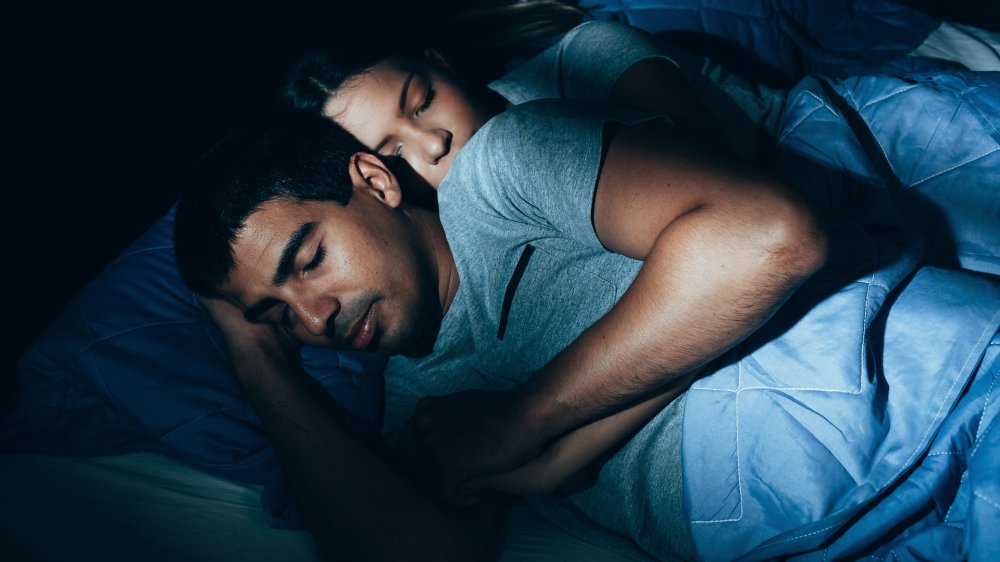What Your Sleeping Position Really Says About Your Relationship
No matter your preferred sleeping position — be it fetal, cradle, or something entirely different — you likely regard your sleeping space (yes, your bed) the same way others do: It's your sanctuary. It is where you rest up, recharge, and reemerge ready to start a brand new day. It is also where you and your partner can cuddle, canoodle, and enjoy some intimate time together.
Snuggling in bed can increase sexual satisfaction, enhance feelings of happiness, and provide a surge of affection. It can also decrease blood pressure, diminish pain, reduce anxiety, and boost your immune system, according to Healthline. Beyond these basics, though, it can also speak to your relationship.
Whether you prefer to fall asleep wrapped up in each other's arms or retreat to your separate sides of the bed, how you sleep as a couple can indicate a few key facts (or assumptions) about your dynamic. Do you nod off face to face, back to back, or butt to butt? Are you tangled up in each other all night long — or have you decided to try sleeping in separate beds? We are breaking down all the interesting hidden meanings behind your co-snoozing patterns and bedtime body language.
The spooning position
Whether you're the little spoon or the big spoon, nothing feels as warm and cozy as a skin-to-skin snuggle session. And as explained by sex therapist Shannon Chavez in Men's Health, it's a way for couples to be close "in a sensual manner that's not necessarily sexual." Furthermore, sex coach Pam Costa doubled down on this, telling the magazine that spooning causes a spike in the feel-good love hormone, oxytocin.
In other words, spooning promotes intimacy and makes you feel content. But staying in that position overnight might have you feeling less than comfortable. As pointed out by New York-based psychotherapist Rebecca Hendrix, "Our bodies are basically electric blankets and when we put them next to each other as spoons, it can cause quite a lot of heat, which can make sleeping difficult."
This body-on-body warmth might be a good reason to try "loose" spooning instead. As noted by Healthline, this relaxed version of cuddling gives both partners a bit of breathing room to sleep comfortably, without sacrificing that connection. Intimacy expert Allana Pratt told Health Digest that when you spoon with someone you love it shows that "you have your own back and are comfortable allowing another to have your back, too."
The chasing spoon position
There is one type of spooning that might be less than desirable for both halves of a couple — and that's the chasing spoon. This was dubbed "illegal spooning" by Samuel Dunkell, psychiatrist and author of Good-bye Insomnia, Hello Sleep (via Redbook). It happens when one person retreats to a side of the bed for solo privacy, and the other continues to pursue them for a spoon-style snuggle up.
As explained by psychologist and marital therapist Shirley P. Glass, it can be a confusing move to read. It's likely that the distanced little spoon is angry or frustrated and wants some physical space. It's also possible that he or she "may actually want to be pursued. His or her distancing becomes an invitation." The expert continued, saying, "In this situation, rather than illegal spooning, it's a test, a dance of the spoons."
Of course, this attempt can be somewhat passive aggressive; it's important to be able to pick up on your partner's cues without having to make assumptions. As per the magazine, "sleep positions are a conversation starter, not an instant horoscope."
The pillow talk position
Perhaps you want to gaze into your partner's eyes before your lids get too heavy to keep open. Or maybe you want to dream up big plans for your shared lives as you drift off into Slumber Land. Either way, there's a reason sleeping face-to-face is coined "the pillow talk" position. It may mean you are open to communicating. Furthermore, intimacy Allana Pratt told Health Digest that it could mean "you are ready for anything, good or bad, prepared, brave and ready to face it all."
But, as pointed out by relationship psychologist Corrine Sweet in her research for the bed brand Dreams, if a couple is mirroring each other without touching, the position could also indicate "a need for intimacy and close communication." Furthermore, a study out of University of Hertfordshire cited by Science Daily found that just 4 percent of couples report sleeping face to face throughout the night. The idea of waking up to the sight of your partner's face each morning might be sweet, but the actual snoring in your face — not so much.
The back-to-back position
One might assume that a lack of interaction in sleep is a bad thing — that it could mean you and your partner are not connected physically or emotionally. This is not necessarily the case, though. According to relationship psychologist Corinne Sweet, sleeping in bed back to back means you are each comfortable with yourself and with each other.
Her research indicates that this position known as "liberty" actually "shows both closeness and independence." The best of both worlds — plus, the ability to get some sleep. Intimacy expert, Allana Pratt told Health Digest that if you snooze like this you probably "like your space," and are less "interdependent" in your relationship. In other words, you are confident enough to do your own thing, but comfortable coming together, too. According to Sweet's research, performed on behalf of the bed brand Dreams, 28 percent of couples report sleeping this way.
The moon landing position
If you want your own physical sleeping space but also crave a hint of connection, you might opt for the so-called back-kissing position in bed. Don't worry it's not exactly what it sounds like. Rather, this is when a couple does not face each other, but lays with their backs, or backsides, touching.
Corinne Sweet's research for the brand Dreams indicated that approximately 18 percent of couples choose this position on a nightly basis. As explained by Mind Body Green it is a way to be "connected but independent" in sleep, and "because your butts still touch, you want to stay sexually connected despite your confidence to face in opposite directions."
According to mattress brand Nectar, this "moon landing" position is a "transitional type of sleep position, usually when a couple is going from the beginning romantic moments to something longer and more substantial." So if you and your newish partner sleep with tushies touching, you can feel good knowing you might be moving into a new phase of your relationship.
The lovers' hold position
If you start the night intertwined in each other's arms — tightly embraced in a lover's hold, you most likely gradually unravel throughout the night as you get into a deeper sleep and claim your own physical space. Corinne Sweet, researcher for Dreams brand, dubbed this position the "lovers' knot" and explained that this is "compromise between intimacy and independence, allowing for the best of both worlds."
On the other hand, as pointed out by Healthline, a more "intense" (and potentially uncomfortable) sleep position for couples is one in which they remain in that tangled knot throughout the entire night. "It can only be described as this: an extremely close hug, but lying down. In other words, not a lot of breathing room," the site explained.
Furthermore, Healthline warned that sleeping like this on a regular basis could point to dependency issues — either on your part, your partner's, or both. Indeed, this position may be a sign that more independence is needed in the relationship.
The leg hug position
According to Redbook, sleeping with one leg casually draped over your partner's may indicate "that you or your husband are ambivalent about expressing affection or intentionally withholding it." On the other hand, "it may also speak of healthy camaraderie." Dr. Shirley P. Glass, a marriage therapist, told the magazine that linking your legs may mean you feel completely content and entirely comfortable with your partner.
Yes, it seems that your body language could be saying multiple things in this situation. According to Healthline, if both of your legs are wrapped up together, it may mean you are on the same page physically and emotionally. If it is just one person's leg looking for comfort, though, it may be indicative of "a slight imbalance in the relationship." Nevertheless, the site pointed out that the leg hug is versatile and gives people the ability to sleep in multiple positions while still making and maintaining some contact.
The cliffhanger position
Not facing your partner in sleep might be one thing, but retreating to the far opposite side of your king-size bed might feel (or look) a little hostile. However, this is usually not indicative of relationship problems. Of course, there are those instances when partners will huff, puff, and give each other ample space during or after an argument, claiming your own side and keeping apart during those precious hours of Zzz's might be better for your individual and collective health.
Evany Thomas, author of The Secret Language of Sleep, explained to the New York Post, "It can look like they're in a huge argument, but t's really a couple that has just found a love of personal space." The article elaborated that a "Cliffhanger" position, in which "each person is curled up in opposite-facing fetal poses, can be one of the healthiest moves a couple can make."
And if you're not happy with your sleep position or what it may say about you and your partner, Thomas suggests switching things up. "Trying new sleeping arrangements can be used in an almost prescriptive manner as an alternative to couples therapy," she revealed.
The starfish position
Do you — or your partner — hog the bed? Steal the covers? Spread out to claim the entire mattress? If so, it may be the right time to have a little chat. As noted by HuffPost, this "starfish" position is a bit, well, "selfish." The offending party is driving their partner to the edge — literally and maybe metaphorically, too. Relationship psychologist and sleep researcher Corrine Sweet explained to the publication that this happens when "one partner dominates the space, while the other takes a secondary role."
Whether or not you or your partner sleeps like a starfish, though, a dominant position can be determined by where your head falls as you sleep. If a couple is aligned head to head, they have equal roles. A person whose head is nearer to the headboard might take a more assertive role, while someone who scoots down may be more submissive and lower self-esteem, Sweet told the publication.
The fetal position
According to the Better Sleep Council, 47 percent of snoozers report curling up in the fetal position and sleeping like a baby (literally). Healthline noted, though, that this position can lead to lower back pain and discomfort throughout the stomach — so if you and your mirrored partner wake up with aches, this may be why. Lengthening your sleep position a bit will help, as will placing a wedge or pillow between your knees to better align your hips and body.
And, by the way, if you and your other half curl up in bed around your furry best friend, that's a whole other story. As mattress brand, Casper, explained, "For some couples, placing a pet in between them can serve as a way to get some extra space at night as well as reinforce the strong bond between you and your pet." That said, there are some legitimate reasons your pets shouldn't sleep in your bed — and we're not just talking hygiene. While you and your partner sleeping alongside Fido may strengthen the bond you both have with him, it could mean you're also "avoiding something in your relationship." After all, you have a living barrier separating you.
The interlocked hands position
Holding hands with your significant other is about as sweet and simple as it gets. And, yes, it may give you that warm and fuzzy feeling. Relationship coach Toni Coleman told Women's Health, "it feels good to hold hands with someone we know because it's all about wanting to be close to them." Furthermore, she explained that holding hands can trigger the release of oxytocin, and can even be akin to a more subtle form of foreplay.
And if you fall asleep while locked hand in hand? It may mean that, while you are both independent sleepers, you still want to feel connected. Body language expert an author Maryann Karinch told Well+Good that any form of light touch reiterates that bond and shows care. Similarly, engaging in a game of footsies in the middle of the night is "just very playful, it's still comfortable but very exciting."
The stomach-sleeping position
Stomach sleeping can say some things about your relationship. "When doing so with a partner, it can symbolize a lack of trust and a degree of vulnerability," Healthline revealed. If you and your partner are both stomach sleepers, you might also be unhappy when you awake the next morning — but not necessarily about your relationship. Rather, it could be due to the aches and pains associated with being a tummy snoozer.
As noted by the publication, sleeping on your stomach is generally not the greatest option for your overall health and comfort, as it is "taxing for your back and neck" and "can lead to poor sleep." One potential upside to the position, though? It may reduce snoring. So if sleeping on your stomach helps provide some silence for your bedmate and enables you to get better sleep, it could actually — in a way — be good for your relationship.
Either way, if this is your go-to position, take a tip from Neil Robinson, chief sleep officer of Sealy UK, and put a pillow under your pelvis to give your spine better alignment (via Healthline).
The cradle position
A cradle cuddle and the so-called "shingle" position are relatively similar. As noted by mattress brand, Casper, the former involves "one partner resting their head on the other partner's chest, with their legs intertwined," while the latter is a position in which "both partners [sleep] on their backs, with one partner resting his or her head on the other's shoulder." Both exhibit a level of protectiveness and romance.
Marriage therapist Dr. Shirley P. Glass told Redbook that in the cradle, there is a "strengthening sense of comradeship." She continued, saying, "There's a high level of trust here. You're like a turtle on its back, exposing yourself, open to all kinds of touching."
If this position isn't comfortable for you, try the reverse shingle, as suggested by the magazine: "Lie facedown, with your body overlapping" your partner's. Author and psychiatrist Samuel Dunkell said that this position shows that you are totally tuned into your significant other — "even in sleep."
The separate bed sleepers
If you sleep in separate beds, it does not necessarily mean your relationship is doomed. It's possible — and likely — that you just really, really like (nay, cherish!) your sleep. Wendy Toxel, a behavioral and social scientist, wrote on TED Ideas that the thinking that a couple needs to physically sleep in a shared space in order to have a healthy partnership "is largely a socially constructed belief system, not science based."
In fact, as confirmed by a study in the journal Sleep, couples who do share a bed through the night tend to lose out on precious Zzz's — and, at the very least, the quality of their slumber suffers. To that end, you could argue that sleeping in the same bed could cause more frustration than satisfaction. If you decide to try dueling beds, Toxel advised keeping the lines of communication open. "If sleeping apart seems like the right choice for you as a couple, try to think of it not as a filing for sleep divorce but as forging a sleep alliance," she explained.















